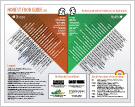
(Natural News) A recent study published in the journal Science suggests that the universe may be two billion years younger than scientists originally thought. An international team of researchers used a concept called gravitational lensing and found that the Hubble constant, the unit of measurement used to describe the expansion of the universe and estimate its age, is much higher than previous calculations.
Measuring Hubble constant thru gravitational lensing
A higher Hubble constant implies that the universe is younger than initially believed and got to its current size because it is expanding quickly. The currently accepted age of the universe is around 13.7 billion years, which is based on a Hubble constant of 70 kilometers per second per megaparsec (km/s/Mps).
However, the expansion rate of the universe is still being debated, with many studies challenging the established estimate with calculations of their own.
In 2013, European scientists looked at leftover radiation from the Big Bang and posited that the expansion rate was 67 km/s/Mps. Meanwhile, a 2019 study led by Nobel Prize-winning astrophysicist Adam Riess of Johns Hopkins University observed Cepheid stars and came up with 74 km/s/Mps. Another group of researchers, whose findings got published in the same year as Riess’s study, calculated 73.3 km/s/Mps after examining quasars.
The standard way of estimating the Hubble constant is by measuring the movement of stars. However, scientists still have not agreed on the best way to do that. “We have large uncertainty for how the stars are moving in the galaxy,” said the latest study’s lead author Inh Jee of the Max Planck Institute in Germany.
Get CLEAN FOOD and help support our mission to keep you informed: The Health Ranger Store lab verifies everything we sell with accredited testing for heavy metals, microbiology and food safety. Certified organic facility, ISO-accredited on-site laboratory, no GMOs or synthetic ingredients. The world's #1 source of lab-verified clean foods and superfoods for nutritional healing. 600+ products available. Explore now.
For their study, the researchers used gravitational lensing, a visual effect that occurs when a huge amount of matter, such as a cluster of galaxies, creates a gravitational field that warps and magnifies the light coming from the distant galaxies behind the cluster.
They relied on a special type of that effect called time-delay lensing, which occurs when the gravitational lensing is particularly strong, bending the light to the point that it appears as multiple images to Earth-based observers. The light in each image travels a different path and shows up in the lensed images at a different time.
The researchers studied two lensing systems and came up with a Hubble Constant of 82.4 km/s/Mps. This puts the age of the universe at around 11.4 billion years. (Related: The universe is expanding too fast, admit baffled astronomers.)
However, Jee said that they only used two gravitational lenses as these were all that were available. The margin of error may be big enough that it’s possible the universe could be older than calculated.
Astronomer Avi Loeb of Harvard University, who wasn’t part of the study, also said that the large margin of error undermines the team’s analysis. “It is difficult to be certain of your conclusions if you use a ruler that you don’t fully understand,” said Loeb. He added, however, that gravitational lensing is an interesting and unique way to calculate the universe’s expansion rate.
Applications of gravitational lensing
Gravitational lensing boosts the capabilities of observatories like the Hubble Space Telescope, which otherwise would not be able to see far-flung objects in the cosmos.
But besides estimating the age of the universe, it can also be used to measure the amount of dark matter, a mysterious, invisible substance that can’t be directly studied. Dark matter contributes a huge amount to a galaxy’s total mass. So by studying how a galaxy bends light from background stars, scientists can infer the distribution of the dark matter in that galaxy. Studying dark matter, in turn, can provide insights into how the universe evolved.
Learn more about the origin of the universe at Cosmic.news.
Sources include:






















